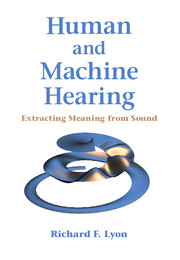Book contents
- Frontmatter
- Dedication
- Contents
- Foreword
- Preface
- Part I Sound Analysis and Representation Overview
- Part II Systems Theory for Hearing
- Part III The Auditory Periphery
- Part IV The Auditory Nervous System
- Part V Learning and Applications
- 24 Neural Networks for Machine Learning
- 25 Feature Spaces
- 26 Sound Search
- 27 Musical Melody Matching
- 28 Other Applications
- Bibliography
- Author Index
- Subject Index
- Plate section
25 - Feature Spaces
from Part V - Learning and Applications
Published online by Cambridge University Press: 28 April 2017
- Frontmatter
- Dedication
- Contents
- Foreword
- Preface
- Part I Sound Analysis and Representation Overview
- Part II Systems Theory for Hearing
- Part III The Auditory Periphery
- Part IV The Auditory Nervous System
- Part V Learning and Applications
- 24 Neural Networks for Machine Learning
- 25 Feature Spaces
- 26 Sound Search
- 27 Musical Melody Matching
- 28 Other Applications
- Bibliography
- Author Index
- Subject Index
- Plate section
Summary
Our sensations are simply effects which are produced in our organs by objective causes; precisely how these effects manifest themselves depends principally and in essence upon the type of apparatus that reacts to the objective causes. What information, then, can the qualities of such sensations give us about the characteristics of the external causes and influences which produce them? Only this: our sensations are signs, not images, of such characteristics. One expects an image to be similar in some respect to the object of which it is an image; in a statue one expects similarity of form, in a drawing similarity of perspective, in a painting similarity of colour. A sign, however, need not be similar in any way to that of which it is a sign. The sole relationship between them is that the same object, appearing under the same conditions, must evoke the same sign; thus different signs always signify different causes or influences.
—“The Facts of Perception,” Hermann Helmholtz (1878)Rather than represent the entire transformation from the set of input variables to the set of output variables by a single neural network function, there is often great benefit in breaking down the mapping into an initial pre-processing stage, followed by the parameterized neural network model itself. … The use of pre-processing can often greatly improve the performance of a pattern recognition system, and there are several reasons why this may be so.
—Neural Networks for Pattern Recognition, C. M. Bishop (1995)The success of machine learning applications, whether in hearing or otherwise, often depends on a good choice of features to represent their input.
Feature extraction is typically a dimensionality reduction. In a sampled sound waveform, every sample is a dimension, in a vector-space conception of the data. Describing a segment of a sound by a spectrum might reduce the number of dimensions from thousands to a hundred or less. Further dimensionality reductions, designed to collapse most of the information into a few dimensions with low correlations between dimensions, are a popular approach in speech and music representation, as well as in image compression (Wintz, 1972). For example, the final transform that makes MFCCs from mel-frequency spectra, as described in Section 5.7, is typically used to reduce about 40 dimensions to about 12.
- Type
- Chapter
- Information
- Human and Machine HearingExtracting Meaning from Sound, pp. 441 - 449Publisher: Cambridge University PressPrint publication year: 2017



